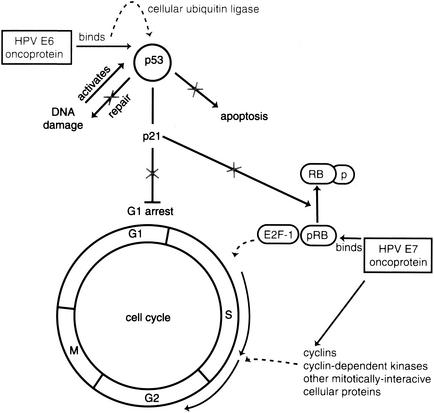Cervical cancer ranks as the fourth most common cancer among women globally and is caused by persistent infection with the Human Papillomavirus (HPV), a small DNA virus known to infect the skin, genital areas, and throat. Based on disease severity, HPV is categorized into low-risk and high-risk types. Persistent infection with high-risk HPV, particularly types 16 and 18, is responsible for 70% of cervical cancer cases due to their potential to cause malignant tumors.
HPV Pathogenesis
HPV E6 and E7 are the primary oncogenes driving cervical carcinogenesis. They play pivotal roles in cellular transformation and maintaining the malignant phenotype of transformed tissues.

Figure. Pathogenesis of oncogenic HPV
Following HPV infection, the E6 and E7 genes are transcribed and translated into their respective proteins. The E6 and E7 proteins bind to host cell tumor suppressor proteins such as p53 and pRB, disrupting normal apoptosis, promoting abnormal tumor cell proliferation, altering the cell cycle, and impairing DNA repair mechanisms, ultimately leading to malignant transformation.
Common detection methods in clinical practice
Detecting HPV E6/E7 proteins, mRNA, or DNA helps identify high-risk populations and provides clinically actionable insights:
- HPV E6/E7 DNA Detection: Determines viral presence but cannot confirm active viral expression or malignant transformation risk. This method has low specificity and high false-positive rates.
- HPV E6/E7 mRNA Detection: Overexpression of E6/E7 mRNA signals viral oncogenic activity, offering a more accurate assessment of malignant transformation risk.
- E6/E7 Protein Detection via Immunocytochemistry or ELISA: Protein expression correlates with cervical lesion severity, particularly in high-risk HPV16/18 infections, where positivity rates rise significantly with lesion grade.
To enable promote the research on the carcinogenic mechanism of high-risk HPV, AntibodySystem introduces the HPV16/18 E6/E7 ELISA Kits. Utilizing a sandwich ELISA principle, these kits deliver high sensitivity for quantifying E6/E7 protein levels in samples!
Key Features of the Kits
Superior Antibodies: High sensitivity, reproducibility, and specificity
Sample type: Serum, plasma
Broad Detection Range: 15.63–1000 pg/mL
High Precision: Intra- assay CV < 15% and inter-assay CV < 10%
Recovery: 80–120%
Product List
|
Product Name |
HPV18 E6/Protein E6 ELISA Kit |
HPV18 E7/Protein E7 ELISA Kit |
HPV16 E6/Protein E6 ELISA Kit |
HPV16 E7/Protein E7 ELISA Kit |
|
Catalog No. |
KVV09001 |
KVV08901 |
KVV09002 |
KVV08902 |
|
Detection method |
Colorimetric |
|||
|
Sample type |
Plasma, Serum |
|||
|
Assay type |
Quantitative (Sandwich) |
|||
|
Sensitivity |
8.72 pg/mL |
10.01 pg/mL |
10.05 pg/mL |
8.98 pg/mL |
|
Range |
15.63 - 1,000 pg/mL |
|||
|
Recovery |
80-120% |
|||
References
[1] Burd, E. M. Human Papillomavirus and Cervical Cancer. Clinical Microbiology Reviews 2003, 16 (1), 1–17.
